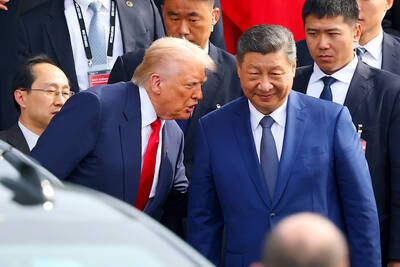Thousands of villagers in southern China clashed with police during a protest against inadequate compensation for farmland flooded by a dam project, a news report said yesterday.
Hong Kong's Mingpao newspaper reported that about 10,000 villagers repeatedly scrapped with police over a four-day period last week when they tried to petition the local government in Guangxi Province's Yantan Township and to hold demonstrations near the dam.
From June 1 through June 4, villagers carrying banners and shouting slogans surrounded the Yantan No. 2 Hydroelectric Power Station's staff residence and marched to the dam site to demand higher compensation, the newspaper said.
It said several hundred soldiers and armed police were trucked in to help contain the protests and five villagers were injured in clashes. Several people were arrested, the report said, without giving numbers.
The paper said Yantan farmland was flooded several years ago when the dam caused the Red River to overflow its banks.
The report said villagers were enraged when the central government allegedly gave Yantan officials 2.8 million yuan (US$370,000) last year to help compensate residents -- but only a portion of it was distributed.
Villagers claimed that local officials pocketed some of the money.
The Mingpao said that villagers had been sporadically protesting the situation since April, but that last week's demonstrations were the largest yet.
The government has been giving every villager a subsidy of 30 yuan per month regardless of how much land they lost, it said.
A Yantan villager, surnamed Li, said that the situation had calmed down and that local officials were negotiating with the villagers, who were demanding 150 yuan a month.

CALL FOR SUPPORT: President William Lai called on lawmakers across party lines to ensure the livelihood of Taiwanese and that national security is protected President William Lai (賴清德) yesterday called for bipartisan support for Taiwan’s investment in self-defense capabilities at the christening and launch of two coast guard vessels at CSBC Corp, Taiwan’s (台灣國際造船) shipyard in Kaohsiung. The Taipei (台北) is the fourth and final ship of the Chiayi-class offshore patrol vessels, and the Siraya (西拉雅) is the Coast Guard Administration’s (CGA) first-ever ocean patrol vessel, the government said. The Taipei is the fourth and final ship of the Chiayi-class offshore patrol vessels with a displacement of about 4,000 tonnes, Lai said. This ship class was ordered as a result of former president Tsai Ing-wen’s (蔡英文) 2018

UKRAINE, NVIDIA: The US leader said the subject of Russia’s war had come up ‘very strongly,’ while Jenson Huang was hoping that the conversation was good Chinese President Xi Jinping (習近平) and US President Donald Trump had differing takes following their meeting in Busan, South Korea, yesterday. Xi said that the two sides should complete follow-up work as soon as possible to deliver tangible results that would provide “peace of mind” to China, the US and the rest of the world, while Trump hailed the “great success” of the talks. The two discussed trade, including a deal to reduce tariffs slapped on China for its role in the fentanyl trade, as well as cooperation in ending the war in Ukraine, among other issues, but they did not mention

HOTEL HIRING: An official said that hoteliers could begin hiring migrant workers next year, but must adhere to a rule requiring a NT$2,000 salary hike for Taiwanese The government is to allow the hospitality industry to recruit mid-level migrant workers for housekeeping and three other lines of work after the Executive Yuan yesterday approved a proposal by the Ministry of Labor. A shortage of workers at hotels and accommodation facilities was discussed at a meeting of the legislature’s Transportation Committee. A 2023 survey conducted by the Tourism Administration found that Taiwan’s lodging industry was short of about 6,600 housekeeping and cleaning workers, the agency said in a report to the committee. The shortage of workers in the industry is being studied, the report said. Hotel and Lodging Division Deputy Director Cheng

‘SECRETS’: While saying China would not attack during his presidency, Donald Trump declined to say how Washington would respond if Beijing were to take military action US President Donald Trump said that China would not take military action against Taiwan while he is president, as the Chinese leaders “know the consequences.” Trump made the statement during an interview on CBS’ 60 Minutes program that aired on Sunday, a few days after his meeting with Chinese President Xi Jinping (習近平) in South Korea. “He [Xi] has openly said, and his people have openly said at meetings, ‘we would never do anything while President Trump is president,’ because they know the consequences,” Trump said in the interview. However, he repeatedly declined to say exactly how Washington would respond in